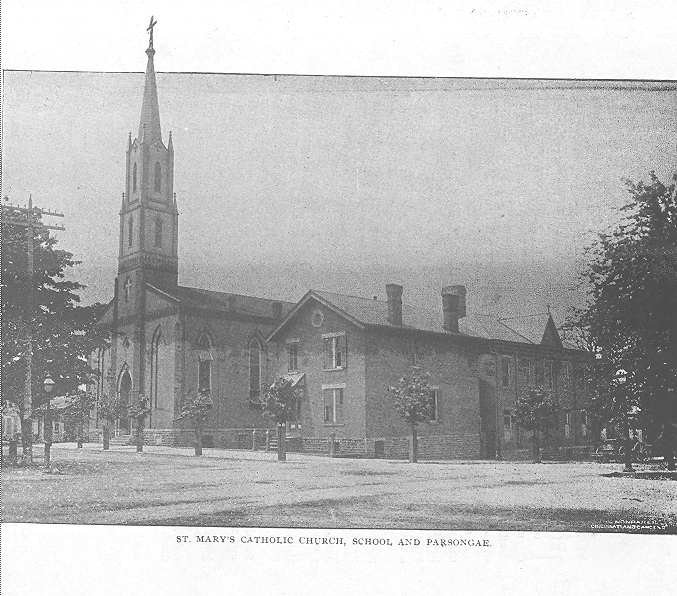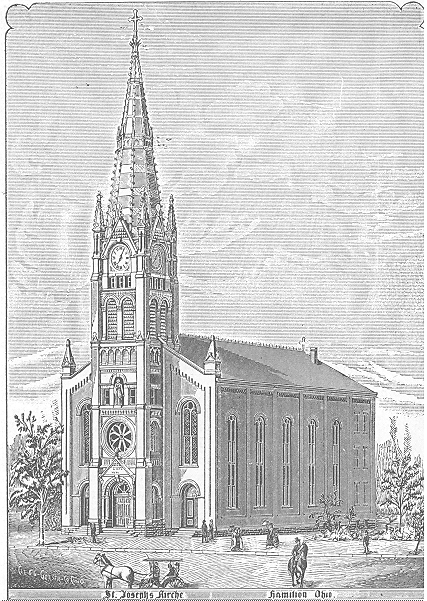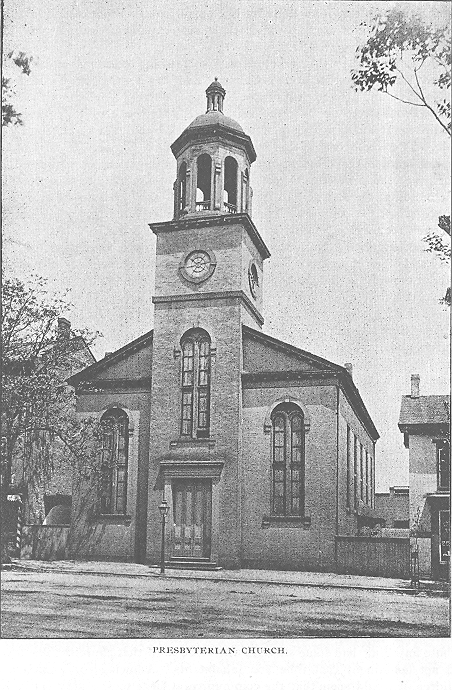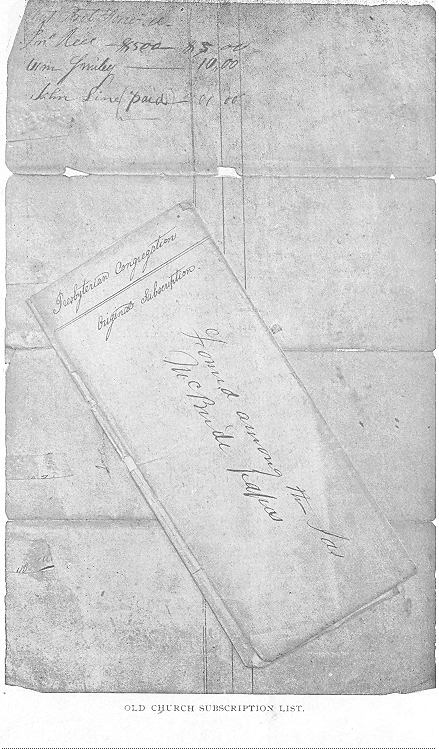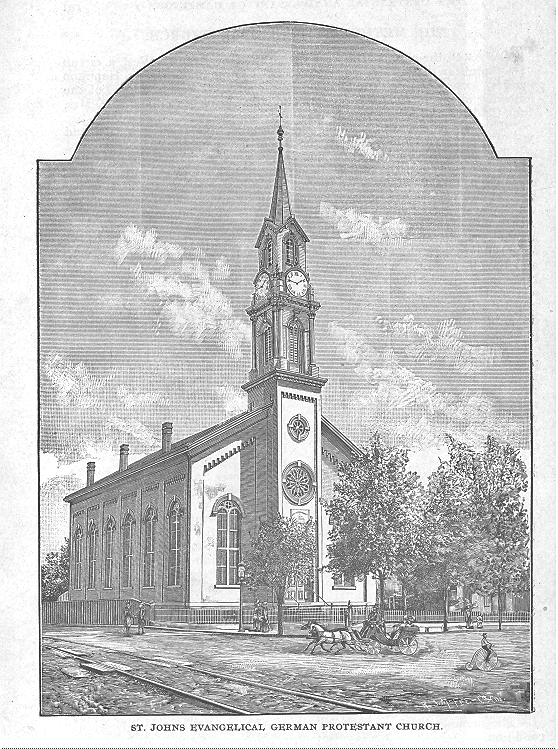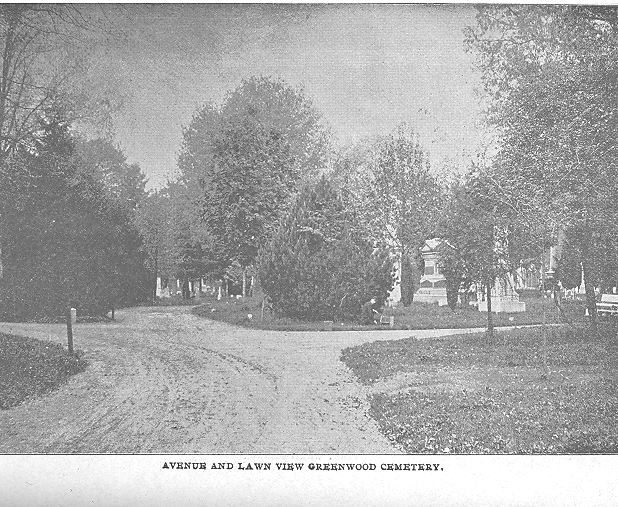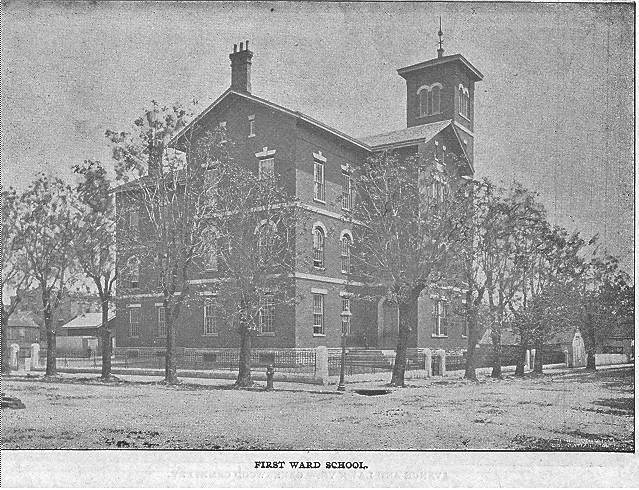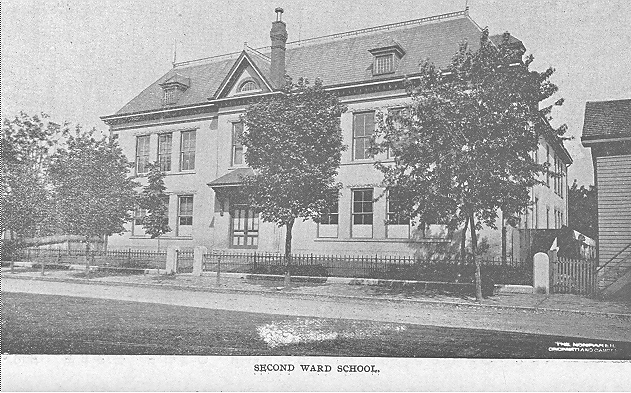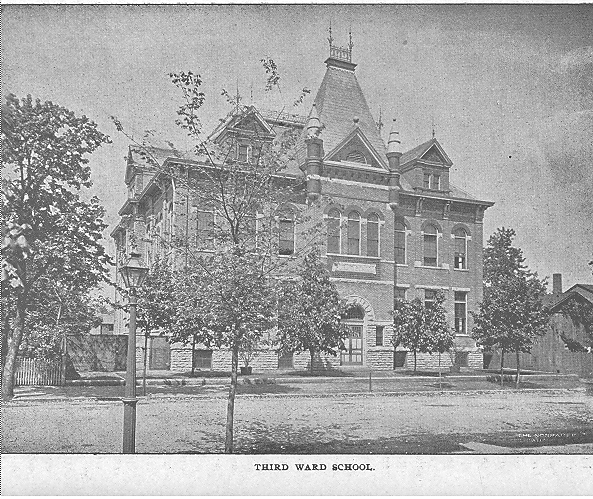150 - THE CENTENNIAL CELEBRATION OF HAMILTON, O.
ments at Fort Washington, and to remove them from the temptation of intemperance which abounded in the vicinity of the Fort, Gen. St. Clair ordered their removal to Ludlow Station, now the upper part of Cincinnati, near College Hill, junction on the Cincinnati, Hamilton and Dayton R. R. Here the Army remained until the 17th of September.
As a precautionary measure, the point to which the Army was to march being at a great distance through a pathless wilderness, he determined to erect Forts at suitable points for furnishing supplies to the troops, for their shelter and also for the protection of the settlers, if any were in that neighborhood. His engineers had already marked out a site at the crossing of the Miami where Hamilton now stands. Capt. John Armstrong who afterwards commanded at this Fort was here on the 2nd and 3rd of August. On the 30th of August, Gen. St. Clair directed Major Hamktramc to move with the troops under his command as soon as the surveyors return from the Miami and report that the route from the Camp to the bank of that river is laid out, move by either of the two lines Mr. Gano has marked out; open a road for the passage of the artillery and two pieces will be sent to you; Choose a defensible position sued as may admit the troops of about three hundred men now here under command of Colonel Darke." His directions for building the Fort are interesting and explicit. "Major Ferguson has orders to mark out the ground for a small fort to be enclosed with pickets. You will employ all the men that can possibly be spared for that purpose, in cutting down pickets, pointing them, and carrying to the place where they are to be put up, agreeable to such directions as Major Ferguson may give. The work will require about twelve hundred pickets. It is my idea that the best way to get it soon finished, is to give the men an easy task for the day and when they have perforated it, that they should be dismissed. I. suppose three men will very easily cut down, butt and point five pickets, and that seven more, (six of whom with handspikes) will carry them to the ground. If the working parties, then, are divided into squads of ten men, in every one of which there should be three good axe men, and furnished with po'es the exact length the pickets are to be cut to, and a sufficient number of officers and non commissioned officers to over see them, the business would be very soon completed and I take the liberty to recommend this method."
But alas the very soon completion did not cone. Gen. Knox Secretary of War was urging and pressing St. Clair to move and on the 24th of September wrote to the President that everything at Camp Ludlow was lovely, "that the horses for the Quarter Masters department for transporting the provisions and for the Artillery were provided, and the artillery and ammunition for the infantry were in readiness and the troops which had assembled on the I nth of August, had on that day moved forward to the crossing of Miami and reached the first post of communication."
But alas, military matters and army contractors were as uncertain in
151 - THE CENTENNIAL CELEBRATION OF HAMILTON, O.
those days as in late years. When the sanguine Secretary of War was contemplating, Gen. St. Clair and his hosts at Fort Hamilton, the General was at Fort Washington, and there for more than a month after until the 18th of September, and instead of the rosy color of the readiness of Camp, equipage for soldiers to march, the actual condition as testified to by Major Zeigler was "the pack saddles were too large," the tents infamous, ends being made of crocus" "many hundred dozens of cartridges destroyed," and "the troops not being kept dry were sick in great numbers," "that the clothing for the levees was infamous, as many who arrived at Fort Washington were almost naked" "the powder was tried and found very weak," "that it would carry a ball but a small distance compared with genuine powder," "the axes were too soft and when used would bend up like a dumpling," "the hospital stores were particularly bad."
"That Gen. St. Clair was the first tip in the morning, going from shop to shop to inspect the preparations and was extremely uneasy at the delay and bad condition of affairs. He was really chief artisan and superintended the construction and repair of everything."
But on the 17th of September about three hundred men did start from Fort Ludlow to build Fort Hamilton and were occupied fifteen days in partially building it. Gen. St. Clair said of it, that early in September 1791 under the superintendency of Gen. Butler, Col. Drake and Gibson a fort was laid out on the ground previously reconnoitered to cover the passage of the Miami River, and to form the first link in the chain of communication between Fort Washington and the ultimate object of the campaign. It was a stockade work about fifty yards square, with four bastions, and platforms for cannon on two of them.
On the 30th of September the fort being nearly completed two pieces of artillery were placed upon it and it was named "Fort Hamilton,'' in honor of Alexander Hamilton, then Secretary of the Treasury; At what exact date the balance of the army left Camp Ludlow for Fort Hamilton the historians differ, and there is much confusion in their statements.
Their march evidently was a slow one, leaving Ludlow their course was across through what is now Spring Grove Cemetery thence up the Winton Road on to Hamilton, encamping first on the prairie south of the fort, and about where the — church now stands,
Their march was through a heavily timbered country, the season was wet, and they were ordered to cut the road twenty feet wide for ninety miles, this, and the building of bridges, greatly delayed them. One day it is said, they marched but a mile and a half, and beside this there was a great scarcity of provisions, the men were frequently on half allowance, and they waited until the Quarter-Master went back and hurried it up.
When the army arrived here, it consisted of only two thousand men instead of three thousand effectives promised by the government. A general
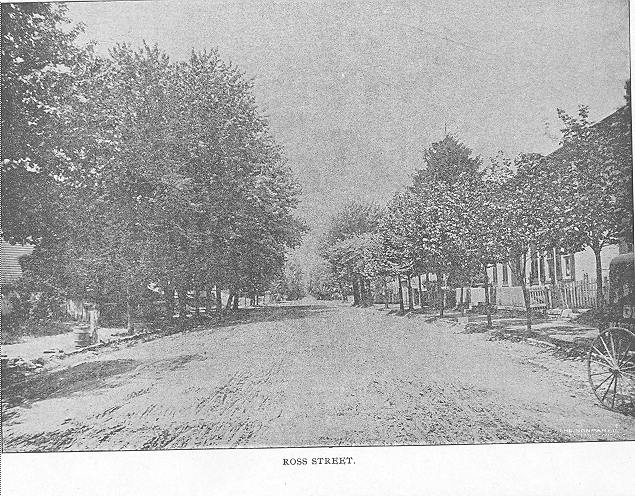
THE CENTENNIAL CELEBRATION OF HAMILTON, O. - 153
description of the fort I take from the history of Butler County. The site selected was immediately on the bank of the river. The upper end of the fort was nearly opposite to where the east end of the bridge from High St. on the Miami River is, and the lower part where the United Presbyterian Church now stands. The ground was then thickly covered with timber, the first thing done was to clear the ground of timber for two or three hundred yards all around. The fort was a stockade work, the whole circuit of which was about one thousand feet, throughout the whole extent of which a trench three feet deep was dug to set in the pickets. The fort was on the first bank of the river, the second bank where the Court House now stands being considerably elevated and within point blank shot, rendered it necessary to have the pickets so high on the land side as to prevent the enemy from seeing in. Four good bastions were made of trunks of trees, one at the northeast angle in High Street, south of where the Post Office now is, north of First Street, on this was a high platform to scour the country and another was on the bastion toward the river to command the ford (which was then opposite the lower part of the town) and the river tip and down. Barracks were erected inside for the accommodation of the officers and the one hundred men. Two store houses, a guard room and some other necessary buildings were erected. The magazine stood at the southeast of the fort near where the United Presbyterian Church now stands. It was built of large square timber, the sides coming close together, and covered with a hip roof. It was used for a jail for many years after the organization of Butler County.
The officers mess room stood near the rear end of the Universalist Church. It was a frame building, forty feet long and twenty feet wide and weatherboarded with rough plank and set on wooden blocks three feet high. The planks for platform, gates and other work and barracks were sawed by the men with a whip saw, often in the work of getting out timber they had only one axe for three men. General Richard Butler and. in command and Capt. Denny, Aid-de camp to Gen. St. Clair joined the army here September 27th, and the army was inspected and mustered by Col. Mentgez, inspector of the army. While they lay here, fifty seven horses were stolen by the Indians in one drove, and on the night of the 3d of October, the night before the army marched, twenty-one men deserted. The army marched on the 4th of October leaving a detachment of troops at the fort to garrison it, under command of Capt John Armstrong.
Gen. St Clair returned to Fort Washington to organize some militia from Kentucky. On the morning of October 4th at eight o'clock the army started under command of Gen. Richard Butler. They crossed the river opposite the lower end of Hamilton and marched a mile and a half to Two Mile Creek and camped on lands since owned by Mr. McClelland. The country was entered unknown to the army, no person with it had ever been through it.
The order of march as directed by Gen. St. Clair was "1st. a small party
154 - THE CENTENNIAL CELEBRATION OF HAMILTON, O.
of riflemen, with Surveyor John S Gano to mark the course of the road 2nd. the road cutters with soldiers to protect them ; ;d. the advanced guard 4th. the army in two columns, with one piece of artillery in front, one in the center, and one in the rear of each column. In the space between the two columns was to march the remaining artillery, designed for the forts to be erected, then the horses with the tents and provisions, then the cattle with their guards who were to remove them in case the enemy appeared. Beyond the columns at the distance of about one hundred yards, was to march the cavalry in file, and beyond them at the same distance, a party of riflemen and scouts for escorts, and then other riflemen to follow the rear guard at a proper distance."
This was a most admirable order for watching an enemy and if necessary forming immediately into battle order.
But this order was changed by Gen. Butler so as to compel the troops to march in one line which required a road to be opened forty feet wide.
October 5th they marched over the hill to Four Mile Creek and encamped where the Fearnot mill has since been built, thence to Seven Mile and encamped on the east side in the southeast of Sec. 24 on lands of Robert Lytle, in Milfotd Township and gave the names to the streams corresponding with the distances from Fort Hamilton, they continued their march north near the east line of Milford Township.
Gen. St. Clair rejoined the army on the 8th and disapproved of the change of the order of march as made by Gen. Butler. Gen. Butler apologized and gave his reasons for the change, which were not satisfactory to Gen. St. Clair; who however permitted it to remain for some days as it might have a bad effect on the officers to see the Commanding Generals disagree, but directed as they advanced into the country where the enemy was likely to be, the original order of march should be resumed.
On the 12th of October they reached a point six miles south of Greenville, Darke County, and began the erection of Fort Jefferson an earth work, (now a station on the Cincinnati, Jackson & Mackinaw R. R.) it was completed, and on the 24th the toilsome march through the wilderness began with very hard rains every night. Gen. St. Clair whose duties through the summer had been very severe, was suffering from severe indispositions, provisions were scarce, the roads wet and heavy, the troops marching with mud and difficulty, seven miles a day ; the militia deserting sixty at a time ; thus toiling along, their numbers lessening by sickness, desertion; and troops sent to arrest deserters, they on the 3rd of November arrived at a branch of the Wabash River where the town of Fort Recovery now is, in Mercer County, 29 miles from Fort Jefferson and on the banks of the creek the army reduced to about fourteen hundred men encamped in two lines.
The spies of the enemy were everywhere about them ; on the 11th fresh
THE CENTENNIAL ANNIVERSARY OF HAMILTON, O. - 155
trails discovered; also at twelve. On the 26th a party sent out to reconnoite, saw five, who escaped. On the night of 29th the whole army awakened, by the sentinel who saw an Indian. On the 28th four of the reconnoitering party were fired on and two killed, one of the others getting into camp and the other missing. On the 30th first signs of Indians skulking around in considerable numbers They had evidently watched and followed our troops all along their march and had made preparations for their attack when a suitable opportunity occurred, for on the morning of the 4th of November, just at daylight, the whole camp was aroused by the attack from a large body of Indians variously estimated from one to three thousand. The troops defended as well as they could the sudden attack, but the slaughter was terrible. The whole camp, which extended 350 yard in length, was completely surrounded and attacked on all sides; the Indians not showing themselves, but firing from the ground. The slaughter was terrible, and our troops compelled to fly from all points; the camp and artil levy abandoned, for not a horse was left alive to draw it off. The enemy pursued for four miles, and others returned to pillage and scalp. One Indian was heard to say afterwards that he tomahawked and scalped the wounded and dead until he was unable to raise his arm. Gen. St. Clair with difficulty was put on one of the few horses remaining but which could not be driven out of a walk, and barely escaped. The loss of our army was terrible. Among the killed were General Butler, Col. Oldham, Major's Ferguson, Hart and Clark; among the wounded: Col. Sayre, Lieut. Col's Darke, Gibson, Major Butler and Aide de camp Viscount McCartie.
There were killed 37 Officers and 550 Privates.
There were wounded 27 Officers and a large number of privates.
The whole country was shocked. Never had a disaster so terribly affected the public mind.
Back through Fort Jefferson and Hamilton on the frozen snow, came the almost naked, half-starved, wounded remainder of the army on its way to Fort Washington he innumerable dead and dying lay scalped and mutilated on the battlefield; their only covering the white snow, which hid their gaping wounds and sightless eyeballs from the cold, cheerless winter sky, which had looked down so pitilessly on that fearful slaughter.
The effect on General Washington when he first learned of it was almost crushing, and his conduct then, as related by Mr. Lear, his private secretary, reveals the strong passions of the man, but which he almost always had under such severe control.
Mr. Lear says: " He paced the room in hurried strides. In his agony lie struck his clenched hands against his fore-head with fearful force, and in a paroxism anguish, exclaimed ; that brave army! so officered, Butler Ferguson ! Kirkwood !—such officers are not to be replaced in a day. That brave artily cut to pieces! oh, God !' Then turning to the secretary, who
156 - THE CENTENNIAL ANNIVERSARY OF HAMILTON, O.
stood amazed at a spectacle so unique as Washington in all his terrors, he continued. `It was here, sir, in this very room that I conversed with St. Clair on the very eve of his departure for the west. I remarked, I shall not interfere, General, with the orders of General Knox and the War Department; they are sufficiently comprehensive and judicious, but as an old soldier, as one whose early life was particularly engaged in Indian warfare, I feel myself competent to counsel. General St. Clair, in three words, beware of surprise! trust not the Indian; leave not your arms for a moment, and when you halt for the night, be sure to fortify your camp—again, and again, General, beware of surprise. And yet that brave army surprised and cut to pieces, with Butler and an host of others slain, oh, God!' Here the struggle ended, as with mighty efforts the Hero chained down the rebellious giant of passion, and Washington became himself again. In a subdued tone of voice he proceeded. " But he shall have justice! yes, long, faithful and meritorious services have their claim. I repeat—he shall have justice!"'
His adopted son, George Washington Park Curtis, in relating this scene says:
" It serves to display this great man as nature had made him, with passions fierce and impetuous, which like the tornado of the tropics, would burst for awhile in awful grandeur, and then shone in higher relief, a serene and brilliant sky. "
St. Clair, worn down by age, disease and the hardships of a frontier campaign, assailed by the press, and the current of popular feeling against him, went to Washington as to a shelter from the storm. With the old friendship Washington extended both hands to him, which St. Clair seized in both of his, and gave vent to his feelings with audible emotion which he could not control.
Yes, Washington did him justice. The old meritorious services were not forgotten, and he took him to his heart as of yore, and retained him as Governor of the Territory, which position he held until November, 1802 when he was removed by Thomas Jefferson. A commission of Congress sustained him in the charges made against him in regard to his conduct at his defeat.
General John S. Gano was sent by Col. Wilkinson at the head of fifty volunteers, among whom was Major William Henry Harrison, afterwards President of the United States, to bury the dead at St. Clairs' defeat. They arrived there safely but found the great depth of snow prevented it, but they returned again afterwards and found the ground literally strewn with the dead. One soldier says he had counted over six hundred skulls, and the bodies were stripped of clothes and terribly mutilated.
The effect of this disaster was to strengthen the resolution of the people, Congress and the public authorities to crush by all means the Indian power. General Anthony Wayne, in 1792, was appointed Commander
THE CENTENNIAL CELEBRATION OF HAMILTON, O. - 157
of the Military Forces, instead of General St. Clair. He was regarded as one of the best Generals in the Revolutionary War. Irresistible in leading a charge, of great impetuosity of character, and who had distinguished himself at Brandywine. Germantown and Monmouth, and in the brilliant charge he led against Stony Point in 1779, at midnight with unloaded muskets, flints out and fixed bayonets, without firing a gun, he carried the fort and took 563 prisoners.
Thenceforth until the close of the war, Fort Hamilton became one of the most important military posts in the West. The brave and efficient officer Capt. John Armstrong was put in command, the garrison was enlarged and put in a state of perfect defense; parties were sent out from it every day to reconnoiter the neighboring woods; for the Indians were watching from beyond the river up and down it, every motion of the guards. Boats were ascending and descending the Miami with supplies from the Ohio River for the army, both here and at Dunlap Station, Fort Jefferson and Ft. St. Clair, and to the commander here was entrusted the duty of guarding the river and fords. He was to laad the pack horses with supplies for interior forts and stations and provide suitable escorts to guard them. He was by express to keep a constant communication with every part of the army from Ft. Washington to the extremest part, and to send relief as rapidly as possible to any point where danger of savage attack was imminent. He was to provide as far as possible forage for the horses, and the correspondence between him and the commander at Fort Washington is full of his accounts of the amount of hay he had cut from the adjacent prairies below the town, and the amount he could supply to the troops. He was required to graze cattle and when fat kill them and send them to the forts. He was to make up and sign abstracts of contractors accounts.
He was to guard the river, to watch for crafts of Indians which silently came down from the head waters of the Miami and were hid in the foliage on the bank, while the owner went in quest of his victims.
The correspondence between the commanders here and Ft. Washington during this stormy period is worthy of being published and read by all.
May 1792, Capt. Armstrong writes to Col. Wilkenson in command of Ft Washington. On the evening of the 5th your letter was handed me by the Corporal conducting the escort. As Indians had shown themselves on the opposite shore for three succeeding days, I detained the escort until the evening of the 6th and in the interval detached Lieutt. Gaines with twenty men, five miles on the road leading to St. Clair with directions to recross Joseph's Creek and to form in ambuscade until the same party pass him which promises an ample reward. The precaution was a wise one for half a mile from the post the escort saw an Indian endeavoring to shoot a deer with an arrow, and on discovering these he gave a yell which was answered by three or four others, the horse on which the express had been sent returned
158 - THE CENTENNIAL ANNIVERSARY OF HAMILTON, O.
riderless and at two o'clock a raft on which three or four Indians may have crossed the river floated past the fort. Such were the daily experiences at the fort.
Col. Wilkinson replies to Capt. Armstrong thanking him for the precaution he took to protect his convoy, saying: "I love a man who Minks; too few do so, and none else should command.
March 17, 1792, we have a letter from Capt. Armstrong to Gen. St. Clair informing him that Col. Wilkinson left Fort Hamilton at 10 o'clock yesterday with 200 men to establish an intermediate fort between this and Fort Jefferson, Amid all this constant care and watchfulness it is pleasant to read these letters to see how promptly and earnestly their duties were performed, and in what courteous language they addressed each other.
As a specimen of gallantry I doubt whether one from Capt. Armstrong to Mrs. Gen. St. Clair could be excelled by the most cultivated courtier. She had sent some garden and flower seed to him to be planted in the fort garden and he replies: "I hope, madam, this letter although out of the line of etiquette will not give offense. Unacquainted with the etiquette of addressing a lady, I have hopes, the language of my profession will not beoffensivee to the companion of a brother officer. Be pleased therefore, madam, to accept the thanks of my family, alias the mess, for your polite attention is sending us garden seeds, etc., and should we be honored by a visit from the
donor, the flowers shall be taught to smile at your approach and droop as you retire. We beg you to accept in return a few venison hams which will be delivered to you by Mr. Hartshorne; they will require a little more pickle and some nitre. JOHN ARMSTRONG.
In the spring 1793, Capt. Armstrong much to the regret of Gen. Wayne resigned his position as commander of Fort Hamilton and returned to Columbia where he married and settled for many years. He was appointed Treasurer of the Northwest Territory in 1796 and again in 1799 and at the expiration of his term removed to a farm in Clark County, Indiana, where, he died in 18i6, having sustained a character for the highest integrity patriotism and bravery. He was succeeded in Command by Major Rudolph a brave officer, but of a stern character, who arrived at the fort late in the, fall of 1792 with a corps of men. It is said that he refused to suspend for a moment the sentence of death pronounced against seven young soldiers for desertion, although he knew an appeal for their case was pending before Col Wilkinson, but had them shot in the presence of four hundred soldiers where the church stands west of the Court House. A few moments after the death the messenger arrived with the reprieve of a portion of them. Gen. Wayne w: s so incensed at his cruelty that heordered his immediate resignation and dismissal. It is said that he afterward chartered a vessel and went on a trading expedition to England, but was captured by pirates and hung at the yard arm of his own vessel. In his stead Gen. Wayne appointed
THE CENTENNIAL ANNIVERSARY OF HAMILTON, O - 159
Major Cass, a distinguished soldier of the Revolutionary war and father of Gen. Lewis Cass, who commanded at the fort until it was abandoned. His career while here was marked by tact, courage and a close attention to every requirement which would aid the Commander-in-Chief in his after successful campaigns
Gen Wayne proceeded to organize his army at Hobson Choice where the Gas Works and Union Depot now stands in Cincinnati, and after spending some time waiting the tardy action of Congress, and in drilling at Ludlow Station whence Gen. St. Clair started in 1791, left that station on the 7th of Oct. 1793, and cutting his way through the woods along where now lies-Spring Grove Avenue, Elan wood, Carthage, Lockland over Foster Hill, Wood lawn, through Glendale and Springdale in Hamilton Co. along the coursce of the present turnpike arrived, at Fort Hamilton and encamped on the prairie a short distance below the town and threw up breastworks, which it is said could be seen for many years near Trabers Mills. Gen. Wayne then took nearly the line of march of Gen. St. Clair and arrived at Greenville on the 13th. Here he was joined by 1000 mounted Kentuckians. He sent forward and built and garrisoned Fort Recovery on the site of St. Clair's defeat. Gen. Wayne remained at Greenville until the 28th of July following, waiting attempts to make peace with the Indians, and preparing his forces for battle if these efforts failed. Thence he moved to the junction of the Maumee and Auglaize and built Fort Defiance. On the 20th of August 1794, he was victorious over the combined Indian forces at Fallen Timbers on the Maumee River near Perrysburg, and on the 3d of August 1795, concluded a peace with them by the treaty at Greenville. Being in bad health he started on his return to Pennsylvania, but died at Presque Isle, now Erie, Pennsylvania, Dec. 14, 1796 at the age of 51 years. He was at his own request buried at the foot of the fiagstaff of the fort, and afterwards his son removed his remains to Radnor churchyard in Delaware County, Pennsylvania. While his name as Mad Anthony struck terror to the enemy. it was always a tower of strength to the American cause, and he will live in history as one ofthe ablest commanders of his time.
After the treaty at Greenville, in 1795, the army was disbanded and a number of the officers and soldiers returned to Hamilton, the only settlers living near them were said to be Charles Bruce on the river a mile and a half above the fort, and David Beaty who built a cabin on the bank of the pond one mile south of the fort.
Fort Hamilton was occupied as a garrison until the summer of 1796 when the public stores were sold at auction and the fort abandoned.
What grand historical recollections this old fort brings to the mind. The history of the men who commanded and controlled it and that of the country during the five years of its existence should be read by every lover
160 - THE CENTENNIAL CELEBRATION OF HAMILTON, O.
of his country. Through the most trying years of our country, they toiled bled and died to free this then a wilderness from savage power and open it up to civilization. The more than one hundred Vice-Presidents on this platform, each of whom was born in this county more than eighty years ago. I doubt not could tell you how their fathers and mothers handed down to them the history of those perilous times, and what security they felt when the government established Fort Hamilton; how their hearts sank within them at the news of St. Clair's defeat, and with what rejoicing they saw the strong, sturdy, determined face of Wayne, as he marched here on his way to
retrieve that bloody defeat.
There is now a venerable lady on this platform, Mrs. Keck, 88 years old who at present is the only living person here who saw General Arthur St. Clair. Her husband was one of the musicians who played at his funeral.
The building of the fort here meant danger, war; its destruction, the signal of a glorious victory and peace. Thereafter its site was destined to be occupied by all the arts of peace and avenues of trade. The factory, mercantile house, the house of the laborer, the church, the schoolhouse the temple of justice—what a transformation I see all around me; from the wilderness with the lurking savage, the frowning fort, the open-mouthed cannon, the armed soldier, to this scene of civilization. Immense factories, magnificent churches, and schoolhouses, this grand court house, railroads running through your midst carrying the commerce and passengers of the world to all depots, the electric roads carrying for a small fare, the twenty thousand inhabitants of your city to all parts of it, where their business, or pleasure, may call; and over your heads electric telephone wires are strung by which `on can converse with each other for miles apart, and electric telegraph by means of which you may every hour touch the throbbing pulse of the world.
But the growth is not confined to your city. Your county is noted for the richness of its soil, and all over it one may travel for miles through the finest cultivated and improved farms of our state, passing through towns and villiages full of indnstrious people and happy homes.
Twelve miles north is Middletown, wilh its hydraulic works, manufactories, electric lights, magnificent churches, school house and opera house handsome dwellings, one of the most enterprising manufacturing cities of our state; affording occupation and subsistence to a population of eight thousand.
A like distance west is the beautifnl village of Oxford, set as if on the very apex of the round globe. Celebrated for her educational institutes Female Seminaries, and that grand old college, Miami University; with the reminiscences clinging around it of Dr. Bishop, Scott, McGuffy, and many others, and from which have gone forth into high public life more men than
THE CENTENNIAL ANNIVERSARY OF HAMILTON, O. - 161
from any other educational institution west of the Alleghenies. You may call the rolls of her sons, and they answer here, from the pulpit, the United States Senate, the Governor's mansion, the highest seat in the arena of the lawyers ; and from the chair of President of the United States, and over the hospitalities of the house his wife, the daughter of one of the Professors, who with the old cheerful face the boys fifty years ago so well remembered, Prof. Scott, now 92 years of age, watches his children and grand children as they frolic in that beautiful place.
Your people have ever answered to the call of your country for men to defend her. Many marched with St. Clair, Wayne and Harrison, and their bones lie mouldering at Ft. Recovery, Ft. Jefferson, Fallen Timbers, River Raisin, Tippecanoe, at Resaca and Moline Del Ray in Mexico, and on every battlefield of the War of the Rebellion, from Bull Run to Appomattox Court House; and when your mothers shall be called upon to produce their jewels, they can point to the green hillocks under which their sons lie and say they are hidden there until the great day when the Master shall make them up in his crown.
If I had time I would like to speak individually of the brave men and women who have toiled in different spheres to bring about this great transformation before me.—Of John Reily, member of the first Continental Convention of Ohio; famous teacher and Clerk of your Court for years —Of Joseph Hough, the merchant, who for thirteen years annually bought his goods in Philadelphia, transported them over the Alleghany mountains in Cone stage wagons to Pittsburg, and down the Ohio on flat-boats to Cincinnati, and up to Hamilton in wagons ; and in selling them, as money was scarce, took his pay in wheat, corn, pork and beef. He then packed and shipped it from this point in flat-boats down the Miami River to the Ohio and Mississippi to New Orleans and selling out for cash returned with it through the wilderness and many savage tribes, and then back again to Philadelphia for more goods. Such labor and perseverance exceeds anything, in the way of mercantile ventures of which I have ever read.—Of brave and upright Joel Collins.—Of James McBride, merchant, historian and architect.—Of Henry S. Earhart, John W. Erwin and John C. Skinner, all worthy to be mentioned as engineers who surveyed for your splendid system of hydraulics; and every railroad and turnpike in the county.—Of John Woods, eminent lawyer, who as Auditor of the State brought your financial matters out of chaos into shape, and who was fore-most in every matter pertaining to your interest.—William Bebb, lawyer and Governor of your State.--Of Lewis D. Campbell, Member of Congress, Minister to Mexico, and prominent in your business affairs. John B. Weller, Member of Congress and Governor of California.—Matthew and Thomas Hueston and Israel Paxton of Wayne's army, at the battle of Fallen Timbers.—Of Drs. Robert and David Millikin, prominent physicians—Of the many prominent
162 - - THE CENTENNIAL CELEBRATION OF HAMILTON, O.
men in all departments, who in bygone years have labored to give character to your county.
I cannot close without speaking of the sad ending of the life of Gen. St. Clair. No man ever questioned his bravery, integrity or faithfulness to the cause of American liberty. For it he sacrificed all he had, a large fortune, domestic ease, the affection of the friends, and when the credit of the government would not enable him to provide supplies for his army, gave his own individual promise to pay what amounted to about five thousand dollars, for which his home and lands which had cost him fifty thousand dollars were sold. The government under one pretext or another refused to reimburse him, although his claim was strongly urged by Henry Clay, Gen. Wm. H Harrison and many others of the best men of the nation. He finished his' career at 81 years, the keeper of a wayside inn, a log cabin on Chestnut Ridge, Pennsylvania, having for a long time been in the most abject want Of the pension of sixty dollars per month wrung from Congress from very shame, not one cent reached him, for it was seized by a hard hearted creditor at the very door of the Treasury.
These three days of the celebration of your centennial, will be an inspi ration to your children and to all who shall come here after this day. It will teach them to read what their pioneer forefathers and mothers have done and suffered, that this land might be made a goodly heritage for them ; and as they read the many incidents as related by the speakers on this occasion, and by the long list of men who for more than four score years have lived and grown up here, in what was so dense and hostile a wilderness, they will thank God, as we do here today, that we are a People and have such a Nation and history of which to be proud.
PART III.
HAMILTON:
-- ITS --
Municipality, Churches, Schools and Courts
HAMILTON, OHIO.

THE CENTENNIAL, ANNIVERSARY OF HAMILTON, O. - 165
HAMILTON:—Its Municipality.
BY L. M. LARSH
THE City of Hamilton, now containing a prosperous population of upwards of 20,000, is comprised of what was Formerly the villages of Hamilton and Rossville. Hamilton was laid out
and platted by Israel Ludlow on the 17th day of December, 1794, and was called 'Fairfield," but the name was shortly afterwards changed to "Hamilton," and was, in the year 1810 was incorporated under that name by a special act of the Ohio Legislature. Soon after Ludlow laid out the village it was determined to establish the county seat of Butler County Hamilton, and, by way of inducement to secure the County Seat, Ludlow set apart for the use of the County for public buildings, the square no occupied by the Court House and surrounding park ; and for a church cemetery the square in the Fourth ward now occupied as "Ludlow Park.
The village of Rossville was laid out and platted on March 14th 1891 by Jacob Burnett, John Sutherland and others.
The villages of Hamilton and Rossville constituted separate municipalities until the annexation of Rossville to Hamilton, in the year 1854.
On the 17th day of January, 1827, the Ohio Legislature passed an act incorporating the "Towns of Hamilton and Rossville," and provided for separate organizations. No preceeding or action of any kind was ever had under the law.
The villages continued their separate existences until their consolidation in the year 1854. There was nothing peculiar or worthy of note in their administration prior to the ordinances adopted for annexation. Unless it be a fact that a generous fraternal rivalry existed between the citizens of the respective villages.
The vote taken on the first Monday of April, 1854, on the proposition to annex the village of Rossville to the village of Hamilton resulted as follows to-wit :
In Hamilton, for annexation - - - - 331 votes
“ against " - - - - 149
In Rossville, for annexation - - - 159
“ against '' - - - - 80
making in the two villages a majority of 261 votes in favor of the proposition
166 - THE CENTENNIAL CELEBRATION OF HAMILTON, O.
in a total of 719 votes cast.
After consolidation a new organization for the government of Hamilton was effected under the general statutes of the state regulating municipal corporations. From the village the municipality became a town, and thence forward was designated as the town of Hamilton. The town was divided into three wards, one west of the Miami river and two east of the river, High street being their dividing line. A Mayor, Marshal and Town Council of two members from each ward, were elected, and the government of the town was duly inaugurated, and was continued as such until by progress and increase of its population to 5,000 as required by law, the Town of Hamilton became the City of Hamilton in the year 1857.
It belonged to the grade of cities designated in the Statute of Ohio, as second class, and under the present statute of the state, classifying municipal corporations, Hamilton is a city of the second class and third grade.
The several census taken by the United States shows the following as the population of Hamilton and Rossville combined until the consolidation in 1854, and thereafter of the City of Hamilton, to-wit :
